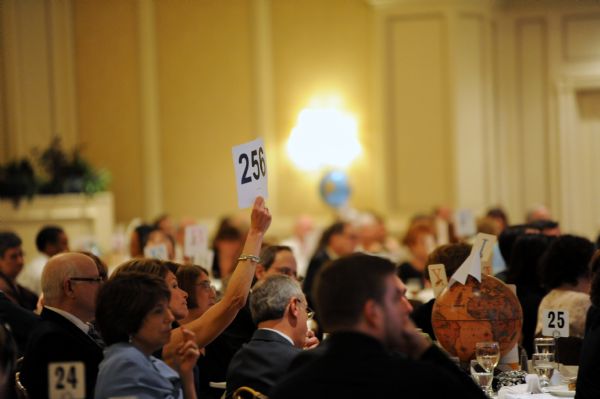SMJCS gets $2.2 million in recent fundraising
Published April 18, 2012
Just months after its creation, the new Saul Mirowitz Jewish Community School finds itself celebrating both promising fundraising figures and a healthy enrollment total.
“We hope to achieve our goal by the summer,” said head of school Cheryl Maayan. “We’ll keep working on it because we really believe that this has the power to positively affect the St. Louis Jewish community if we make a solid investment in providing the best that is possible in Jewish education.”
The school has already seen a down payment on that investment taking in more than $2 million dollars including a million-dollar matching grant from local couple Ken and Nancy Kranzberg while the recent gala netted another $200,000.
Ken Kranzberg, who pledged the seven-figure matching challenge before the merger, made the funds contingent on the two schools joining. He said it was important to have a top-notch institution to attract the next generation of Jewish professionals. Though Kranzberg, who chairs packaging giant TricorBraun, noted that neither he, nor his children or grandchildren attended a day school, he knows that a solid parochial education system can be a big selling point to bring Jews to St. Louis.
“I believe that any strong Jewish community needs a strong Jewish day school,” he said. “Two Jewish day schools weren’t doing the trick but one Jewish day school can make a huge difference.”
The institution, which formed at the beginning of the year through a merger of Solomon Schechter Day School and Saul Mirowitz Day School-Reform Jewish Academy, is looking to pull in some $3 to $5 million to bolster its coffers. Maayan said the impetus behind the effort is multilayered including both regular operating expenses and an effort to build an endowment, an area where the school is starting from close to square one.
There are also transition costs as the SMDS-RJA moves operations to the Solomon Schechter facility on Congregation B’nai Amoona’s campus. Federation has been helping to defray some of those expenses, which could run as much as three-quarters of a million dollars. Maayan said the school expects to vacate its former home at B’nai El Congregation by the end of June.
But the move and the money are only two of the changes the institution is experiencing. Classroom content is also being combined and reshaped in ways that SMJCS leadership hope will result in something that is more than the sum of its parts.
“We’re using this as an opportunity not just to put two curricula together but to really make a change that will take us a step higher,” said Maayan.
That’s included a heavy focus on technology. Smartboards will now be in every classroom while iPads and laptops will appear as standard equipment. The school has also hired a special position to oversee digital education. The tech revamp should cost about $200,000 and was a major focus of the recent gala where an auction raised some $70,000 to get the ball rolling.
“We are always very concerned that [students] are able to succeed in the world that they are inheriting which is very different than the world that most of us who are donating to the campaign grew up in,” Maayan said. “These kids are going to be taking jobs in 10 or 20 years that haven’t even been created yet and we want to make sure they have a comfort level and facility with technology so they can stay on the cutting edge.”
Other aspects of the curriculum are getting attention as well. Judaics are a particular area of focus. The school was just accepted into the Jewish Day School Standards and Benchmarks Project, funded by the AVI CHAI Foundation and run through New York’s Jewish Theological Seminary. Maayan believes her institution is one of only a handful in the nation accepted into the program, which provides for four site visits a year as well as weekly phone calls from a consultant to augment the lesson plan.
“We have decided on a varied model for Judaic studies, ensuring that the teacher at each grade level is the right person for teaching the subject and is passionate about it to create a depth of discussion,” Maayan said. “It will vary from grade to grade depending on who the teacher is. Some classes will have a general studies teacher who is qualified to teach Judaic studies. Some will have a specialist teaching Judaic studies.”
Enrollment is another number the school has been watching closely. Maayan said the consultants warned that the joined institutions could shed as much as a quarter of their combined headcount but so far that dire prediction hasn’t come true. While about seven percent of students won’t be returning, mostly RJA fifth-graders who had never planned on attending a Jewish middle school and won’t be taking advantage of the new K-8 facility, new enrollees are picking up the slack. Maayan said 154 contracts are already in and she expects the school to hit 170, the previous combined enrollment, by the time the year gets underway.
Michael Rubin, board president, said that despite the challenging philanthropic environment the school’s fundraising efforts are clearly paying off. Leadership took a low-key approach and staged coffee receptions to speak with about 30 possible donors who could make significant gifts.
“We started quietly with a few key people,” said Rubin, who also runs Michael D. Rubin & Associates, a firm that helps non-profits with fundraising. “Most of those people have been very excited about giving.”
The early success has been a big psychological boost, he said.
“We feel there is a lot of momentum being built and it tells us that people are excited about what we are doing,” he said. “Otherwise they would have said forget it.”
















